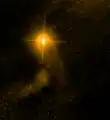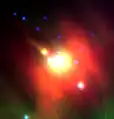| Nebula | |
|---|---|
 Sh-279 as taken from the Mount Lemmon Observatory[1] | |
| Observation data: J2000.0 epoch | |
| Right ascension | 05h 35m 16.2s[2] |
| Declination | −04° 47′ 07″[2] |
| Distance | 1,500 ly |
| Apparent magnitude (V) | 7.0 |
| Apparent dimensions (V) | 40′×25′ (1977) arcmins |
| Constellation | Orion |
| Physical characteristics | |
| Radius | ~7.5 ly (1977), 2 ly (1975) 1 ly (1973) ly |
| Designations | Sh-279, NGC 1977-73-75 |
Sh2-279 (alternatively designated S279 or Sharpless 279) is an HII region and bright nebulae that includes a reflection nebula located in the constellation Orion. It is the northernmost part of the asterism known as Orion's Sword, lying 0.6° north of the Orion Nebula. The reflection nebula embedded in Sh2-279 is popularly known as the Running Man Nebula.[1][3]
Sh2-279[2] comprises three NGC nebulae, NGC 1973, NGC 1975, and NGC 1977[4] that are divided by darker nebulous regions. It also includes the open cluster NGC 1981. The brightest nebulosity, later listed as NGC 1977, was discovered by William Herschel in 1786. He catalogued it as "H V 30" and described "!! 42 Orionis and neb[ula]". The two smaller reflection nebulae were first noted by German astronomer Heinrich Louis d'Arrest, NGC 1973 in 1862 and NGC 1975 in 1864.[5] All three were included in the New General Catalogue in 1888.[6] The designation NGC 1977 is used in various sources for the reflection area around 42 Orionis (the south-east portion of the reflection nebula), for the entire reflection nebula (including NGC 1973 and NGC 1975), or for the whole nebula complex.[5]
This whole region in Orion's Sword was also later catalogued as Orion 1c. In 1966, van den Bergh distinguished the weak clustering of reflection nebulae that includes Sh2-279 as Ori R2.[7] Every reflection nebula appearing within the Sharpless catalogue was first identified on blue plates of the Palomar Sky Survey, and then double checked against the red plates to eliminate possible plate faults. Van den Berg found that there was a strong concentration of new T Tauri stars around the Orion Nebula, tapering off into a tail approaching Sh2-279.[7]
The Running Man Nebula is a popular target for amateur astrophotographers, as it lies close to the Orion Nebula and has many nearby guide stars. The outline of the running man shows up primarily in photographs; it is difficult to perceive visually through telescopes, though the reflection nebula itself is visible in small to medium apertures in dark skies.
Ionization Source
The whole reflection nebula region is likely excited by the hot young star (YSO) called c Orionis, 42 Orionis or HD 37018[8] in NGC 1977,[9] which appears as a 4.6 magnitude star some 3.8′ from the centre of Sh2-279. (See image box.) Other massive stars include the yellow giant 45 Orionis and the variable KX Orionis.[10]
Proplyds in NGC 1977
One candidate proplyd was discovered in NGC 1977 with the Hubble Space Telescope in 2012. The object showed a bent protostellar jet and a possible ionization front facing 42 Orionis, suggesting it is a proplyd.[11] In 2016 a group of astronomers discovered six proplyds with the Hubble Space Telescope and one proplyd with the Spitzer Space Telescope. The proplyds are pointing to the B-star 42 Orionis, which is the main source of ultraviolet radiation in this region. This ultraviolet light is photoevaporating the proto-planetary disks and the stellar wind of 42 Orionis is shaping the gas into cometary tails. Proplyds were first discovered in large numbers in the Orion Nebula, but there the ultraviolet source responsible for the photoevaporation is the O-type star Theta1 Orionis C. 42 Orionis is the first instance of a B-type star being responsible for the photoevaporation.[9]
All proplyds in NGC 1977 lie within 0.3 parsec of 42 Orionis and two have resolved central sources in the Hubble images, which might be the disks with radii of about 70 and 48 astronomical units.[9]
NGC 1977 also includes the young star Parengo 2042 (P 2042).[12]
Image gallery
 Image of the Running Man nebula and its proximity to the Orion nebula.
Image of the Running Man nebula and its proximity to the Orion nebula. NGC 1977, Running Man Nebula, by W4SM using 17" PlaneWave CDK, Louisa, VA
NGC 1977, Running Man Nebula, by W4SM using 17" PlaneWave CDK, Louisa, VA
 Proplyd imaged by the Spitzer Space Telescope is the elongated object on the upper left. 42 Orionis is in the middle and it is surrounded by glowing dust.
Proplyd imaged by the Spitzer Space Telescope is the elongated object on the upper left. 42 Orionis is in the middle and it is surrounded by glowing dust.
References
- 1 2 Normandin, George P. "NGC 1977, NGC 1975, and NGC 1973, Running Man Nebula". www.kopernik.org. Retrieved 5 March 2017.
- 1 2 3 "SH 2-279". SIMBAD. Centre de données astronomiques de Strasbourg. Retrieved 12 March 2017.
- ↑ "'Running Man' Races in Spectacular Nebula Photo". Space.com. 12 June 2013. Retrieved 5 March 2017.
- ↑ "APOD: 2007 December 20 - Reflections on the 1970s". apod.nasa.gov. Retrieved 5 March 2017.
- 1 2 Peterson, D.E.; Megeath, S.T. (2008). The Orion Molecular Cloud 2/3 and NGC 1977 Regions : Handbook of Star Forming Regions, Volume I: The Northern Sky ASP Monograph Publications, Vol. 4. Edited by Bo Reipurth. ASP. pp. 590–618. arXiv:0809.4006. Bibcode:2008hsf1.book..590P.
- ↑ Dreyer, J. L. E. (1888). "A New General Catalogue of Nebulae and Clusters of Stars, being the Catalogue of the late Sir John F.W. Herschel, Bart., revised, corrected, and enlarged" (PDF). Memoirs of the Royal Astronomical Society. 49: 1–237. Bibcode:1888MmRAS..49....1D.
- 1 2 van den Bergh, S. (1966). "A study of reflection nebulae". Astrophysical Journal. 71: 990–998. Bibcode:1966AJ.....71..990V. doi:10.1086/109995.
- ↑ "* c Ori". SIMBAD. Centre de données astronomiques de Strasbourg. Retrieved 12 March 2017.
- 1 2 3 Kim, J.S.; Clarke, C.J.; Fang, M.; Facchini, S. (2016). "Proplyds Around a B1 Star: 42 Orionis in NGC 1977". Astrophysical Journal Letters. 82 (1): L15–L20. arXiv:1606.08271. Bibcode:2016ApJ...826L..15K. doi:10.3847/2041-8205/826/1/L15. S2CID 118562469.
- ↑ Johnson, H. M.; Snow, T. P. Jr.; Gehrz, R. D.; Hackwell, J. A. (1977). "Copernicus spectra and infrared photometry of 42 Orionis". Publications of the Astronomical Society of the Pacific. 89: 165. Bibcode:1977PASP...89..165J. doi:10.1086/130096. ISSN 0004-6280.
- ↑ Bally, John; Youngblood, Allison; Ginsburg, Adam (August 2012). "The Spindle: An Irradiated Disk and Bent Protostellar Jet in Orion". The Astrophysical Journal. 756 (2): 137. Bibcode:2012ApJ...756..137B. doi:10.1088/0004-637X/756/2/137. ISSN 0004-637X.
- ↑ Gianopoulos, Andrea (2021-11-19). "Hubble Spots a Swift Stellar Jet in Running Man Nebula". NASA. Retrieved 2022-09-27.
External links
- NASA Astronomy Picture of the Day: Reflections on the 1970s (2 October 2003)
- Sharpless 279 at Galaxymap Archived 2020-02-18 at the Wayback Machine
- HaLRGB image based on 190 minutes total exposure